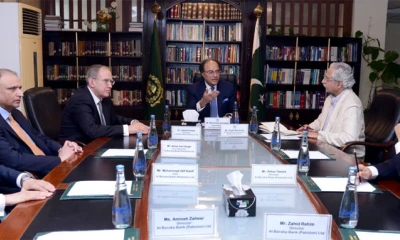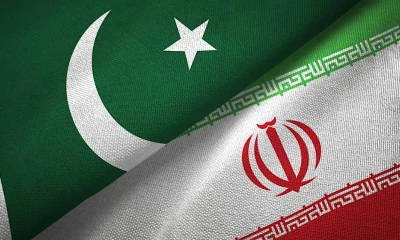Business
Pakistan’s economy to grow 4%, inflation to remain at 7.5% in current fiscal: ADB
After rebounding to 3.9 per cent in fiscal year 2021, Pakistan's economy is projected to hover around 4 per cent in FY22 as business activity gradually resumes in the second year of the coronavirus pandemic, the Asian Development Bank (ADB) said in its latest report on Wednesday.

According to the Asian Development Outlook (ADO) 2021 Update, ADB’s annual flagship economic publication, Pakistan’s economy is expected to continue recovering in the current fiscal year, supported by stronger private investment, improving business activity, a steady vaccine rollout, and economic stimulus measures for FY2022.
Yet, significant uncertainty clouds the economic outlook over the course of the pandemic in Pakistan and worldwide.
“Supported by promising growth in the industry and services sectors Pakistan’s economy is on the path of recovery,” said ADB Country Director for Pakistan, Yong Ye.
“The continued rollout of the COVID-19 vaccination program, structural reforms, and the expansion of social protection programs are all key to ensuring inclusive and sustainable growth.
Fiscal incentives and policies to boost export competitiveness, bolster the performance of the manufacturing sector, and augment private investment will continue to play an instrumental role in strengthening the economic outlook.”
Pakistan’s economic growth in FY21 was supported by improved COVID-19 containment strategies through the second and third waves of infections and continued accommodative fiscal and monetary policies that accelerated the recovery across all sectors.
Growth in industry, predominantly construction and small-scale manufacturing, and services are forecast to improve in FY2022. Agriculture is also expected to continue supporting GDP growth.
Inflation declined to 8.9% in FY21. Food price inflation remained high due to supply chain disruptions, increased prices for wheat and sugarcane, and an extended wet monsoon. Rising international oil prices boosted energy price inflation.
Yet, inflation for other goods eased thanks to the appreciation of the Pakistani rupee and a postponement of planned hikes for electricity tariffs and domestic fuel prices.
The State Bank of Pakistan maintained its policy rate at 7% to support the economic recovery. Investment is expected to strengthen as global sentiment improves and the International Monetary Fund-supported stabilization program continues to progress.
The report has projected Pakistan’s inflation to slow to 7.5% in FY22, unchanged from the forecast in ADO 2021, as food prices moderate with supply chain improvement and production increases facilitated by the government’s Agriculture Transformation Plan. price rises for other goods are expected to moderate as well thanks to tax relief in the FY22 budget.
Inflationary pressures will likely come from ongoing economic recovery and rising global oil prices but should be tempered by expenditure reform and the government’s commitment not to borrow directly from the central bank.
Risk of inflation higher than forecast derives from any unusual increase in oil prices or from potential currency depreciation in the wake of any early winding down of the ongoing IMF program.
The fiscal deficit is forecast to narrow to the equivalent of 6.9% of GDP in FY2022, which is still higher than the target set earlier under a medium-term fiscal consolidation program supported by the IMF. Growth in revenue is projected to accelerate with the rapid pickup in domestic economic activity and higher imports.
Further bolstering revenue growth are the introduction of new tax measures under the Finance Act, 2021; a renewed focus on streamlining tax exemptions; and additional policy and administrative measures to broaden the tax base.
Expenditure is also projected to rise in FY22, as the government has budgeted substantial increases in subsidies and in social and development spending to protect the vulnerable and fortify growth and economic recovery.
Pakistan’s public debt outlook is sustainable in the medium term. With primary and fiscal deficits, high borrowing costs, and currency depreciation, public external debt reached $95.2 billion in FY2021.
However, the government has been implementing a medium-term debt strategy for FY2020–FY2023.
The maturity structure of public debt has improved by reprofiling public debt into longer-term instruments. With strong economic growth prospects for FY2022 and beyond, public debt remains on a downward path over the medium term.
As domestic demand picks up and international oil prices rise, the current account deficit is seen widening to the equivalent of 1.5% of GDP in FY22, which is a smaller deficit than forecast in ADO 2021 in line with the FY21 deficit being smaller than projected.
Accoridng to the report, remittances are likely to remain elevated, supported by the Roshan Digital Accounts initiative, and will continue to narrow the current account deficit.
Export growth is expected to accelerate in FY22, supported by a projected upturn in economic activity in Pakistan’s major trade partners. Exports will further benefit from continued initiatives to reduce the cost of doing business and especially from the government’s newly introduced export facilitation scheme, which allows the duty-and tax-free acquisition of
inputs: intermediate goods, plant, and machinery.
The country's imports are expected to rise in FY22 in response to domestic economic recovery, higher international oil prices, and rationalization of custom and regulatory duties in the FY22 budget, the ADB report concluded.
-

 Pakistan 15 hours ago
Pakistan 15 hours agoTraffic plan released as Iranian President to visit Lahore, Karachi today
-

 Pakistan 14 hours ago
Pakistan 14 hours agoCM Punjab approves establishment of Provincial Enforcement Authority
-

 World 1 day ago
World 1 day agoInt’l Earth Day observed today
-

 Sports 2 days ago
Sports 2 days agoThird T20I: Pakistan set 179-run target for New Zealand
-

 Technology 1 day ago
Technology 1 day agoHow to change or cancel your music streaming services
-

 Pakistan 1 day ago
Pakistan 1 day agoRana Sanaullah claims Imran Khan release no big deal
-

 Pakistan 1 day ago
Pakistan 1 day agoIranian president reaches Pakistan
-

 Pakistan 1 day ago
Pakistan 1 day agoNawaz Sharif to leave for China on four-day visit




























